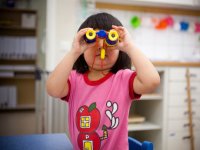Elementary Classroom: Making the Most of the First Month
Your content has been saved!
Go to My Saved Content.Starting off school in the right way is important, as it is in many areas of life. Folks at Responsive Classroom have been studying this process in grades K–6 for years, and have compiled great advice. I'd like to share with you some essential ideas, from them, and from my own experiences in schools.
Setting Goals
The first month of school is about inspiration and security. It may sound like an odd combination, but it's what kids need. Specifically, your first 30 days should explicitly address the following five things:
- Create a sense of belonging and purpose. Students are part of a school and a class that are special and for which students' presence and attendance are important.
- Learn classmates' names and something about them. Keep it simple and age-appropriate.
- Learn and practice some key routines. Routines provide reassurance and a sense of security for students. Take ample time to cover these and practice them. Remember, what is routine for you is likely still a source of apprehension for many students.
- Feel excited and motivated about what's to come. Give kids a sense of how what they will learn will help them.
- Reassure and excite parents. Communicate to parents before and during the first week much more about the exciting things to come and your care for their children than about requirements and tests.
Activities to Assist
Some sample activities to help accomplish the above goals are:
- Give students a chance to express their hopes and dreams for the year. Set up a birthday chart for K–2. For older grades, set up a chart showing favorite books, authors, TV shows, or movies.
- Give students a chance to share "Something about Me."
- Start a Word Wall. Use age-appropriate words your students will learn that open up a sense of excitement and windows to what is coming during the school year. (Some examples of words you can use are: explore, pride, curiosity, creativity, service, scientist, Dr. Seuss, artist/illustrator, classmate, experiment, goal, share, help, cooperate, collaborate, prepare, review, sing, and chant.)
Pay Attention to Key Routines
As noted above, routines provide great reassurance and security. From kindergarten onward, some versions of these are relevant to most classrooms:
- Signals for quiet attention
- Bathroom procedures
- Classroom centers, entries, and exits
- Desks, cubbies, lockers, books, and materials
- Lining up and walking in hallways
- Lunch and dismissal
- When and how to ask questions, including establishing the importance of asking questions, no matter how small
More Activities for the First Month
Finally, the following are some important activities toward reinforcing the goals that can be used the first month and continued throughout the year.
Provide students with opportunities to learn something about one another's families. Alert parents that this lesson is coming so they can help children have clear answers, especially with complicated backgrounds that some families have. Use a United States and world map to begin to help children develop a sense of location, direction, etc.
Start to work on a brief, age-appropriate project for your students to share their favorite book or song. They can use any medium they wish: posters, digital slide show, written list or paragraph, photos, etc. For young children, it may begin with verbal sharing after a little bit of thinking time. Give children a chance to help one another to the extent possible. This is a tremendously valuable diagnostic activity, as you will see children's multiple intelligence strengths, how they plan, how they take advantage of or give help, how well they verbalize and communicate interpersonally, and their overall emotional intelligence and social-emotional competence.
Set a norm of having students help one another with routines.
Create end-of-the-day routines, like reflections about a happy thing that happened in school today, one thing they learned that they most want to remember, a closing song or chant to end the day, or saying something they are looking forward to in school tomorrow.
Find time for a fun, energizing break at least once a day other than the start or end of the day. Chants, songs, games, brief meditations, Mad Libs, group problem solving, imagination and creativity activities -- all of these add tremendous enthusiasm to children and help them stay positive for a day of learning.
